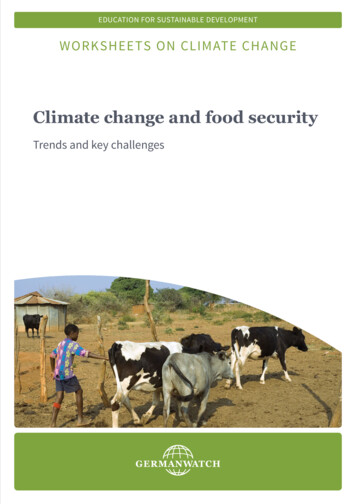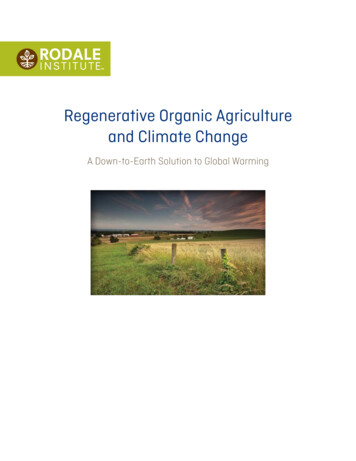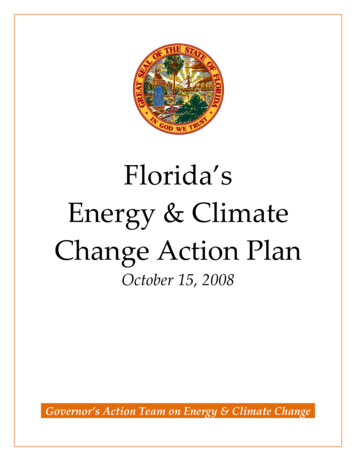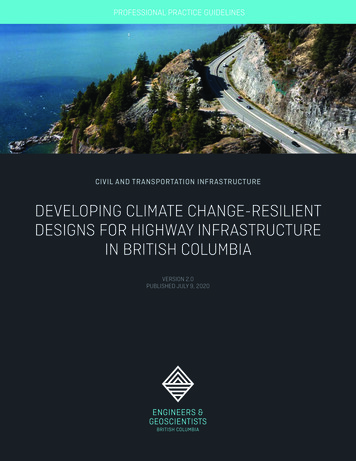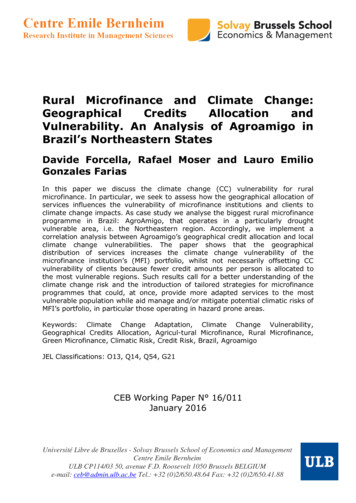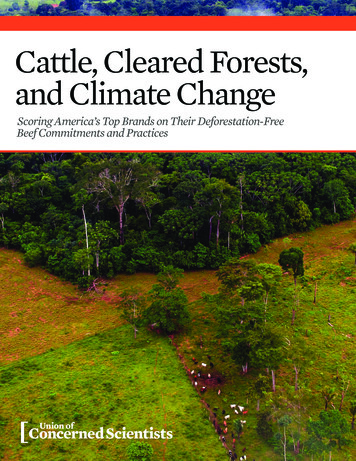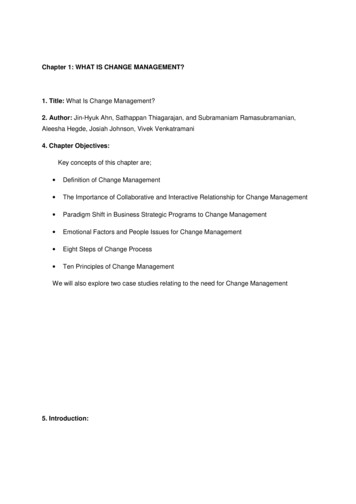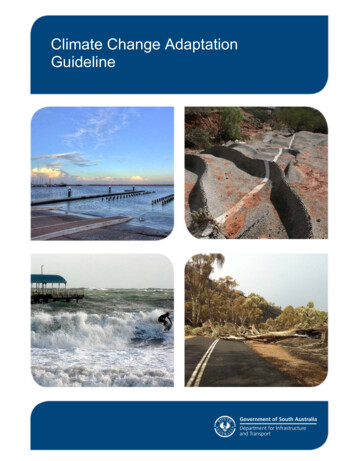
Transcription
Climate Change AdaptationGuideline
Climate Change AdaptationGuidelineFirst published April 2015Copyright Department for Infrastructure and Transport77 Grenfell Street, Adelaide, SA 5000This revised Guideline has been prepared with support from Edge Environment. It has been approved andauthorised for use by Departmental staff and its authorised agents by:For further support and information about this guidance document, please contact:Principal Sustainability Advisor, Technical Servicesph 8343 2398Senior Sustainability Advisor, Technical Servicesph 7109 7501Front cover images (clockwise from top left):King tide at Whyalla boat ramp (source: Whyalla News, 10 July 2014)Flood damage to Andamooka-Olympic Dam Rd, April 2010Bangor bushfire, February 2014King tide at Henley Beach, April 2009 (source: witnesskingtides.org)
Technical Services DirectorateENVIRONMENTStandards & GuidelinesTable of Contents1Introduction1.1South Australian Policy Context1.2Purpose of this document1.3Who should use it?1.4When should the climate change assessment be undertaken?1.5Where should the outcomes be recorded?2Assessment Step 1: Sensitivity screening2.1Screening for direct climate sensitivities2.2Screening for indirect climate sensitivities2.3Evaluating screening outcomes3Assessment Step 2: Climate Risk Analysis3.1Establish the context3.1.1Define objectives3.1.2Identify relevant timeframes and scenarios3.1.3Review current and future climate information3.1.4Understand the regional context3.2Identify and assess climate change risks3.2.1Identify and evaluate risks3.2.2Assess risks3.2.3Decide what is an acceptable level of service3.2.4Note: Climate change impacts on flood risk4Assessment Step 3: Treatment options prioritisation4.1Identify potential treatment options4.1Re-assess residual risk4.2Evaluate the treatment options5Step 4: Risk documentation and review5.1Document the risks and preferred treatment options5.2Assign responsibilityReferences and Further InformationGlossaryAppendix 1: Climate Change Risk Assessment Reporting templateAppendix 2: Climate Change Risk Assessment ChecklistAppendix 3: Potential vulnerabilities of key asset elementsAppendix 4: South Australian Climate Data Maps and TablesAppendix 5: Kempsey-Frederickton Bypass flood impact assessment – Roads and MaritimeServices NSW, 2008 (Knet: 8935418)Appendix 6: Roads and Maritime Services NSW Pacific Highway upgrade (Woolgoola to Ballina)flood impact assessment (Knet: 9273619)Appendix 7: Main Roads WA assessment of the impact of higher temperatures on re-sealfrequencyAppendix 8: Use of Goyder Institute data on the Torrens to Torrens projectAppendix 9: West Lakes tidal flushing system: preliminary assessment of sea level rise impactK-Net Doc 16554163Version No: 8Issue Date: February 13942444647UNCONTROLLED WHEN PRINTED1
Climate Change Adaptation Guideline1 IntroductionAs a manager of significant State infrastructure with a long asset life, the Department forInfrastructure and Transport (the department) has a responsibility to protect its assets against thepotential risks of climate change, and ensure that new buildings and infrastructure are designed tobe resilient to future climate conditions. This will assist the communities we service to become moreresilient to shocks and stresses by maintaining a safe, operational transport infrastructure network.Most of the department’s assets, services and operations are affected by climate impacts. Keyvulnerabilities in the asset portfolio, which may exacerbate the impacts of future climate change,include:-our infrastructure is designed to function under current temperature ranges, rainfall patternsand sea levels;-our maintenance programs are based on historic deterioration rates;-our transport networks cater for current and predicted land use and population distribution; and-our infrastructure is known to be at risk from a range of extreme weather events that can leadto service disruption or damage to critical assets.Climate change means that many of these assumptions are no longer valid, so that long-terminfrastructure now needs to be designed, constructed and operated to be resilient to hotter, drierand stormier climatic conditions, with higher sea levels.In 2015 the department adopted a Climate Change Adaptation Strategy, which commits thedepartment to assessing and responding to future climate risks. The Strategy seeks to mainstreamthe treatment of future climate risk by incorporating it into each business unit’s and eachprogram/project manager’s ongoing risk management procedures (rather than creating separatediscreet processes). In this way, climate risks will be assessed, prioritised, treated and monitoredin accordance with the departments overall risk management framework (DP086), which is alignedto AS/NZS ISO 31000:2009.This Guideline assists staff in the implementation of the Strategy by providing a process forconsidering future climatic risk and treatment options in the management of the department’sprojects, assets and operations. It describes when climate change risk should be considered andhow treatment (adaptation) options can be identified for the short and long term.The Climate Change risk assessment components of this guideline are based on AS 5334-2013 –Climate change adaptation for settlements and infrastructure, a risk-based approach.1.1South Australian Policy ContextThe strategic policy basis for the department’s climate change adaptation response is set out inseveral key state-wide strategic documents. These are summarised in the department’s ClimateChange Strategy.In particular, the Government Action Plan for the state’s Climate Change Adaptation Framework(2012) requires State Government Agencies to:-incorporate climate adaptation into all decision-making; and-manage risks from climate change impacts to government infrastructure and services in suchareas as emergency management, transport, land use planning, environment, health servicesand public housing.This is being done to varying extents by different agencies. The Development division PlanningPolicy library (which forms the basis of all Council Development Plans) includes standardscontrolling development in areas prone to sea level rise and coastal recession.K-Net Doc 16554163Version No: 8Issue Date: February 2021UNCONTROLLED WHEN PRINTED2
Climate Change Adaptation Guideline1.2Purpose of this documentThis guidance document aims to:-assist departmental staff to undertake a climate change risk assessment for the department’sassets, services and operations (to ensure that climate risks can be adequately addressed indecision making)-reduce the department's liability for loss or damage resulting from climate-related events-help to avoid potential economic and community disruption and environmental damage-increase the resilience of the infrastructure network to climate-related shocks and stresses tomaintain service delivery.The guide should be employed for climate risk assessment of the following asset groups:-Existing assets and programs within the department-New assets proposed through the planning of future projects1.3Who should use it?-All staff involved in business risk assessment-Staff and contractors involved in the planning and design of projects and programs.Identification and assessment of climate change impacts should inform business case developmentand initial risk assessment for projects, and potential treatment options should be considered alongwith other design alternatives which inform preliminary planning and design.1.4When should the climate change assessment be undertaken?Climate change risks should be considered whenever planning work or risk assessments areundertaken for an asset or program. This includes:-regular, ongoing risk assessments for existing assets and programs, which are undertaken inaccordance with DP086 Risk Management Policy; and-risk assessments undertaken during concept development and project initiation/planningphases.Where a climate change assessment has recently been carried out for a project of a similar nature(ie similar location, similar asset elements and design life), it may be appropriate to utilise theseassessments to identify applicable climate change risks and mitigation measures for the project.DIT Technical Services Sustainability team should be consulted to provide advice and access tothe risk assessment as appropriate.1.5Where should the outcomes be recorded?The same process should be followed for climate change risks as for any other risks identified andmanaged by departmental staff, i.e.:-Organisational risks are recorded in the Corporate Risk Register or in risk databasesmaintained by business units (eg OrgRisk);-Risks and treatment options identified during the initiation and planning phases for newprojects and programs should be documented as part of the project business case and theProject Definition Report. They should also be recorded in the project’s risk register, andreviewed and updated as the project progresses.A template is provided in Appendix 1 to assist in documenting the climate change assessment. Itis strongly suggested that this is employed when reporting on a climate risk assessment for a DITasset. Also included in Appendix 2 is a Climate Change Risk Assessment Checklist, which mustbe completed when undertaking assessments using this Guideline and submitted with assessmentreports as an Appendix. The purpose of this checklist is to ensure that all mandatory tasks requiredby DIT in undertaking a climate change assessment have been completed.K-Net Doc 16554163Version No: 8Issue Date: February 2021UNCONTROLLED WHEN PRINTED3
Climate Change Adaptation GuidelineAn overview of the climate change assessment process is shown in Figure 1.Step 1:ScreeningIs the asset/ program sensitive toclimate impacts?NoNo further actionrequired.NoDocument rationale.No further actionYesReview climate projections. Willclimate change impacts manifestwithin the design life or planninghorizon of the asset or program?YesStep 2:Climate riskanalysisIdentify climate risks. For each climaterisk, consider the nature and extent of theimpact: What does the relevant climateprojection mean for the project/ asset/program? How will it impact the level of service? When will it become an issue/ whendoes a decision need to be made?Document rationale.Is more detailed modellingrequired?YesComplete detailedanalysis to assessextent of climate riskbefore proceeding toStep 3Identify and evaluate potential treatmentoptions.Step 3:Treatmentoptionsprioritisation How do they address the relevantrisk(s) What are the implications for level ofservice? What are the costs/ benefits of upfrontvs staged adaptation? What are other stakeholders doing?Are adaptation actions complementary?Rate treated and untreated risks to assignpriority and determine risk acceptancelevels.Step 4:DocumentationFigure 1Document the preferred treatment option,including rationale. Ensure residual risksare integrated into relevant risk register/asset management plan for tracking andmanagementOverview and decision tree of the department’s climate change assessment processK-Net Doc 16554163Version No: 8Issue Date: February 2021UNCONTROLLED WHEN PRINTED4
Climate Change Adaptation Guideline2 Assessment Step 1: Sensitivity screening2.1Screening for direct climate sensitivitiesBoth stresses and shocks related to future climate impacts may directly affect the designand operation of various DIT assets and programs. The table below summarises examplesof direct climate impacts from extremes in temperature on various DIT assets andprograms.Table 1 – Summary of example direct risks from temperature extremes on a selection of DIT assets / programs.Asset / ProgramRoadsRail programBuildingsDirect risks - temperature extremesStressesIncreased wear and tear of spraysealed surfaces and reduced assetlifetimeReduced overall passengercomfort due to increasedtemperaturesIncreased operational costs due toincreased loads on air conditioningsystemsShocksExtreme heat leading to direct damage toroad surfaceImpacts of scheduling of construction/maintenance workInability for air conditioning to maintainthermal comfortThe first step in undertaking a climate change assessment is to determine which elementsof the project/asset/program are sensitive to climate impacts, and are therefore potentiallysusceptible to climate change.To support the identification of relevant climate sensitivities, staff assessors may find ituseful to review the following sources:- The summary of climate impacts initially identified by departmental staff in 2011/12(Findings from climate change workshops held with department staff in 2012, Knet:9320116)- The summary of common asset element vulnerabilities for buildings, roads andbridges identified in Appendix 3- Draw on internal knowledge and experience of the asset/ activity and how it is impactedby climate conditions.2.2Screening for indirect climate sensitivitiesInfrastructure assets and programs exist within and depend upon a wider network ofsupporting assets and systems. Climate change impacts on this network may haveimportant indirect implications for the resilience of the asset being assessed and shouldtherefore be identified and managed where possible.The Infrastructure Sustainability Council of Australia (2018) describes indirect climate risksas impacts on another system or asset that may disrupt the operational capacity of theasset being assessed. Indirect risks can be upstream, internal or downstream, asdescribed below:K-Net Doc 16554163Version No: 8Issue Date: February 2021UNCONTROLLED WHEN PRINTED5
Climate Change Adaptation GuidelineTable 2 – Summary of indirect risk types and key examples.Indirect risktypeUpstreamInternalDownstreamDescriptionRisk examplesThe products or services providedto one infrastructure by anotherexternal infrastructure that arenecessary to support its operationsand functions.T
3 Assessment Step 2: Climate Risk Analysis 7 3.1 Establish the context 7 3.1.1 Define objectives 7 3.1.2 Identify relevant timeframes and scenarios 7 3.1.3 Review current and future climate information 7 3.1.4 Understand the regional context 8 3.2 Identify and assess climate change risks 8 3.2.1 Identify and evaluate risks 9 3.2.2 Assess risks 9 3.2.3 Decide what is an acceptable level of .




